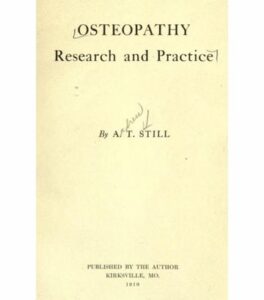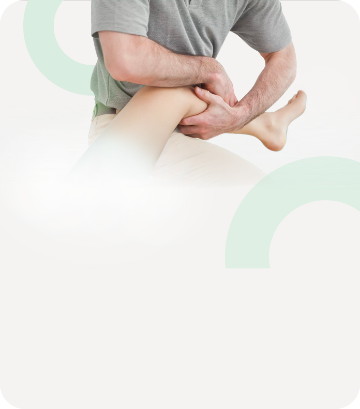Osteopathy Research and Practice by Andrew Taylor Still
The fourth book of A.T. Still, written at the age of 82 years, enunciates the principles and the practical maneuvers of osteopathy in reference to the single pathologies, classified by body regions.
 Publisher: Press of the Pioneer Company, St. Paul, Minn. (USA)
Publisher: Press of the Pioneer Company, St. Paul, Minn. (USA)
Year of publication: 1910
Number of pages: 568
In the preface Dr A.T. Still claims that he has classified the effects of abnormalities of the human body (the so-called diseases) on the basis of the nervous and blood supply of the affected region. This classification cannot be too rigid, and also some pathologies affect bigger regions, as, for example those linked to the area above or below the diaphragm, or to the vertebral region. Fever and contagious diseases are grouped apart.
A.T. Still declares to have included many definitions quoted from the most recent medical dictionaries by Dunglison and Dorland, considered authoritative voices in this field, and expresses respect and gratitude towards all physicians of the present and of the past who honestly strived to alleviate human suffering. He declares to agree with many contemporary physicians about the inutility of the pharmacologic system in use in nineteenth-century America.
He remembers carrying out in-depth anatomy studies and having completed five years of training in mechanical science, and to have developed osteopathy on the basis of these notions. Osteopathy is based on the principle that when all parts of the body function correctly there is health. Sickness is only an effect.
The volume is not organized into chapters but into a succession of numbered individual paragraphs.
The first part is dedicated to the fundamental principles of osteopathy:
- A.T. Still states to have written this book with the only purpose to help osteopaths to reflect on the effect of diseases in order to find their cause, which is often not visible (§6). He reiterates that osteopathy is both a science and a philosophy (§7). He Intends to give instructions to the student to become “a man of reason and prove his talk by his work” (§7). The volume is intentionally written in a simple language to allow its accessibility to everyone.
- A.T. Still reports his “platform” (§13-22) in which he declares himself contrary to the use of drugs, vaccines and serums, favorable to surgery only as last resort, and against mixing osteopathy with other types of therapies (electricity, X-rays, hydrotherapy and others).
- In a small chapter entitled “the brotherhood of life” he points out how all the organs in the body cooperate together, and how all of them function correctly when there is plenty of nourishment and a reasonable amount of rest and amusement (§23). It has to be born in mind that the lesions to any part of the body affect all the others (§24).
- A.T. Still hypothesizes that the physical form could be a “second placenta” which is abandoned by the human beings at the end of their life in order to continue their mental development (§31). He reiterates that his experience was gained in two different worlds, the uncertain world of traditional medicine and the precise world of the mechanical studies, and to have conceived osteopathy as a mechanical science after 35 years of study (§33-34).
- According to A.T. Still, God is the architect who created the perfection of Nature, and this is the foundation of osteopathy (§41). In §44–52 he traces a parallel between the human body and a city, to highlight the importance of all the body systems, organs and apparatuses one more time. Afterwards he restates the importance of blood (§53-59), comparing arterial blood to a “living seed” which makes the human body prosper.
- To maintain themselves, all organs of the body have to obey the general law of demand, offer, construction and renovation. The osteopath needs to maintain the “engine” perfectly regulated (§61). Based on the dysfunction present in the body he has to seek the cause of it (§62-64).
- A.T. Still claims that the “philosofìphy of manipulation” (§66-68) is based on the perfect knowledge of all forms and functions of the human body. During 35 years of study, A.T. Still affirms to have reasoned not only on the shape of each bone but also on the reason why its shape and function are different from those of the other bones. §73 concerns the objective examination. §79 and §82 contain the questions osteopaths should ask themselves to find the cause of the symptoms.
- A.T. Still says that it is necessary to place the bone into its place and leave it, without paying attention to the crack that many patients interpret as a proof of the efficacy of the treatment (§83). He recommends releasing the muscles and the ligaments adjacent to a bone before putting it back into place (§84), describing, for example, the techniques used for the correction of the hip (§85) and shoulder (§86). In §91 refers that there are many ways to fix the bones, and that each practitioner needs to find their way.
The book continues with the parts dedicated to each region of the body.
A.T. Still starts from the head region, which he considers as the body organ or department in which both the force and the majority of nervous fluids utilized in the rest of the body are generated. Nevertheless, he highlights the interdependence between head and the other organs, essential for the good functioning of the organism. Like in the volumes previously written he highlights the importance of the reasoning. He declares that, first of all, it is necessary to assure a good arterial supply and a good venous drainage in the region of the head, which may be prevented by a mal positioning of a bone of the neck or thorax. A description of the single pathologies follows, each correlated with other paragraphs explaining their etiology and the recommended treatment.
After the region of the head A.T. Still focuses on the head and neck, thoracic and abdominal regions, and the regions above and below the diaphragm.
A part dedicated to obstetrics is next. Here some instructions are given on the appropriate treatment to prevent laceration (§555).
- More specifically, A.T. Still recommends to position the mother in a semi-erect position, resting on an inverted chair placed on the bed, with the aim to reduce the uterine and abdominal weight and facilitate the passage of the head of the fetus through the pelvis while the head itself will move the perineum backwards and out of the area of action.
- To avoid lacerations, the practitioner will have to position themselves on the right side of the patient, collocating the left-hand fingers in a way to exert a firm pressure on the symphysis, pushing the soft tissues downwards. they will have to place the thumb of the right hand over one of the ischial tuberosities, and the fingers of the same hand on the other tuberosity, in order to support the perineum with the ulnar edge of the hand, strongly compressing the tissues against the bones (§555).
A part dedicated to the vertebral region is next.
The penultimate part focuses on contagious diseases and fevers, the last one on miscellaneous subjects, including a brief discussion on osteopathy, which A.T. Still defines as a discipline created on American land where people think with their own head.
Finally, A.T. Still expresses some considerations on the nature of life. For example he affirms that: “Life is a substance which fills all of the space of the whole universe”; ” Life is the God, the wisdom, the power and the motion of all” (§907); ” Life in man is itself a man and the body is the empire he controls. The region of the heart is his headquarters where all orders effecting the whole living government, man’s body, are given and received.” (§910).
As a conclusion, A.T. Still specifies that the emperor reigning on the living human being is not necessarily as big as the empire itself, just like a woman who presides and governs a house is much smaller than the house itself. ” life in man and beast is an organized being of per- fect purity of material and mind with powers so great that but little space in the body is required” (§911).
Strengths: Osteopathy Research and Practice is the only volume in which A.T. Still gives practical instruction on the modalities to follow to carry out the treatments. The analytical index at the end of the book facilitates its consultation.
Weaknesses: As for the rest of A.T. Still ’s work, the weak point is the language, which despite being simple may result obscure at times.



Libri storici di osteopatia
History of Osteopathy and Twentieth-Century Medical Practice by Emmons Rutledge Booth
A milestone in the history of osteopathy. Emmons Rutledge Booth, who enrolled at the ASO in Kirksville in 1898 and graduated in 1900, met A.T. Still personally.
LeggiPhilosophy of Osteopathy by Andrew Taylor Still
The second book published by A.T. Still, it collects the basic principles of osteopathy, written over several years and then gathered in one volume. Despite the insistence of his friends, Still was not sure that the time was ripe to divulge his early science.
Leggi


